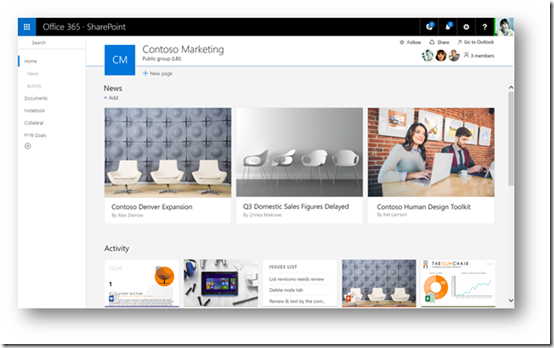Office 365 Groups or Team Sites? No need to have that discussion any more!
Posted
Wednesday, May 4, 2016 3:21 PM
by
CoreyRoth
Any time Microsoft releases a new feature that has an overlap with a new feature, we see a flurry of fluff in the form of blog posts and even sessions on which feature to use when? When Office 365 Groups came out, this was no exception. What has changed? At the Future of SharePoint event, Microsoft announced that every group in Office 365 will benefit from an associated Team Site. Every Office 365 Group you create will get a new modern Team Site provisioned that shows a clear linkage to the Group.

That’s pretty cool and should help eliminate the confusion on what to use when since you no longer have to make a decision. Microsoft has also stated that existing Office 365 Groups (as in the ones you have now) will also get a Team Site associated with them as well. This means whatever you are doing now, it’s ok. You’ll be in good shape when the new features are rolled out.
The updated Team Site home page provides a quick way to find the most important and relevant content on the site. Content and news can be pinned to the front page and the Office Graph is baked right in to highlight activity relevant to you. What’s even better is that you can even access it through the new SharePoint mobile app.
Another exciting change from the new Team Site experience is that they will be provisioned faster. Whereas, it used to take several minutes to provision a site collection, now it should only be a matter of seconds.
Between the Office 365 Group, the new team site home page, and existing team sites, we haven’t seen quite how all of this ties together yet. It will be interested to see where things go.
This isn’t out yet, where should I put content right now?
Ok, so the conversation is not quite dead yet. For now, if you need features that are only in Team Sites such as workflow or metadata, use a Team Site. If you don’t care about Metadata and the document library in Office 365 Groups is good enough for you, then use that. As you can see, Office 365 Groups is really starting to tie everything together.